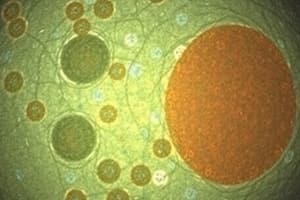Podcast
Questions and Answers
What happens to the surface area-to-volume (SA/V) ratio as a cell increases in size?
What happens to the surface area-to-volume (SA/V) ratio as a cell increases in size?
- It oscillates, often improving cellular function.
- It increases, facilitating nutrient exchange.
- It decreases, hindering waste removal. (correct)
- It remains constant, allowing easy management of resources.
What triggers a cell to enter the cell cycle and prepare for division?
What triggers a cell to enter the cell cycle and prepare for division?
- Reduction in nutrient absorption capacity.
- SA/V ratio becoming too small. (correct)
- High surface area relative to volume.
- Increased waste accumulation within the cell.
Which scenario describes an increased SA/V ratio in a cell?
Which scenario describes an increased SA/V ratio in a cell?
- A smaller cell efficiently transporting nutrients. (correct)
- A larger cell that struggles with waste management.
- A highly elongated cell with minimal volume.
- A spherical cell with maximum volume.
What is the primary consequence of a decreased SA/V ratio in cells?
What is the primary consequence of a decreased SA/V ratio in cells?
In terms of cell growth, what does a small SA/V ratio indicate?
In terms of cell growth, what does a small SA/V ratio indicate?
Flashcards
SA/V Ratio
SA/V Ratio
The ratio of a cell's surface area to its volume.
Decreasing SA/V Ratio
Decreasing SA/V Ratio
When a cell's surface area is small compared to its volume, making it difficult to transport nutrients and waste products efficiently.
Increasing SA/V Ratio
Increasing SA/V Ratio
When a cell's surface area is large compared to its volume, making it easier to transport nutrients and waste products efficiently.
What happens when the SA/V ratio becomes too small?
What happens when the SA/V ratio becomes too small?
Signup and view all the flashcards
How does a low SA/V ratio relate to the cell cycle?
How does a low SA/V ratio relate to the cell cycle?
Signup and view all the flashcards
Study Notes
Surface Area to Volume Ratio (SA/V) and Cell Cycle
-
The SA/V ratio describes the relationship between a cell's surface area and its volume.
-
Decreasing SA/V Ratio: A larger cell has less surface area relative to its volume, hindering efficient nutrient intake and waste removal.
-
Increasing SA/V Ratio: A smaller cell has more surface area relative to its volume, facilitating efficient nutrient and waste exchange.
-
Impact on Cell Growth: As a cell grows larger, its SA/V ratio decreases. This reduction can lead to inadequate nutrient and waste handling, triggering signals for the cell to enter the cell cycle to divide, thus creating multiple smaller cells with larger SA/V ratios.
Studying That Suits You
Use AI to generate personalized quizzes and flashcards to suit your learning preferences.




